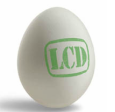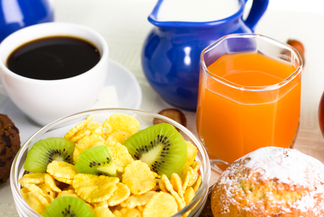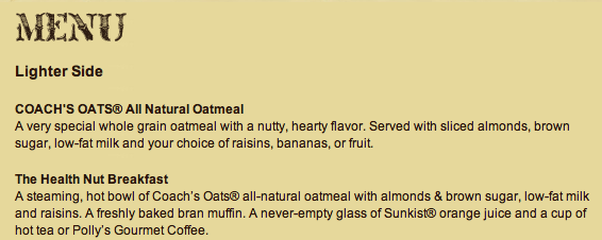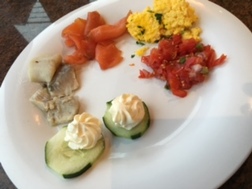What Does a “Healthy” Breakfast Look Like?
It’s not just restaurants who do this, of course. The photo above? That’s an image I purchased from Shutterstock entitled “Healthy Breakfast.” But people are most likely to encounter this message at their favorite eateries.
You may have never eaten at the restaurants whose menus are listed below, but I’m sure you’ll find similar offerings and descriptions at breakfast places in your own city.
“Lighter/Healthy/Smart” Breakfast: Where’s the Protein?
Let’s look at the third one, “The Health Nut Breakfast” under “Lighter Side,” in terms of macronutrient composition. I took a conservative estimate of the amount of oatmeal at one and a half cups, 1 teaspoon of brown sugar, half a cup of low-fat milk, 2 Tablespoons raisins, a 3-ounce bran muffin and an 8-ounce (never-empty?!) glass of orange juice, then entered everything into the My Fitness Pal app. The grand total of carbohydrates for this meal is 129 grams, with 11 grams of fiber, for a net carb count of 118 grams, most of which are rapidly digested and absorbed into the bloodstream. On the other hand, the protein content for this meal is only 15 grams, primarily from grains, which are considered an inferior source of protein compared to the type found in animals, including eggs, dairy, and meat. Compare this to a meal of three pancakes with a quarter cup of syrup, and you’ll see that the amount of net carbohydrates and protein is very similar.
In my opinion, advertising the three meals above as being the best choices on the menu for the health conscious is very misleading. If someone wants to have waffles at the Waffle House and eat them with the realization that their meal isn’t all that nutritious, I have no problem with that. But I do take issue with restaurants advertising carb-heavy breakfasts with juice as “healthy,” because it’s the people who have made a conscious decision to eat well that end up ordering them. This often results in similar high-carb meals consumed at home as well, compounding the problem. I can’t count the number of people with diabetes or weight issues who have looked at me suspiciously when I’ve told them that their breakfast of cereal, nonfat milk, banana, and juice is exactly what they should not be starting their day with and that they’d be much better off if eating bacon and eggs instead.Begin the Day with a High-Protein Meal
There have been several recent studies demonstrating the benefits of a protein-based breakfast with low to moderate carbohydrates. In one study of overweight women, those who consumed 30-40 grams of animal protein (sausage and eggs) and less than 15 grams of carbohydrate at breakfast had better satiety, lower blood glucose and insulin levels, and lower calorie intake at lunch compared to women who ate more carbohydrates and less protein in the morning (1). Studies looking at overweight children and adolescents have had similar findings with respect to high-protein breakfasts (2-3). As I stated in a previous post, getting a minimum of 25 grams of protein at each of three meals is particularly important for preventing loss of muscle mass during weight loss (4) and aging (5-6).
Truly Nourishing Breakfast Options
I personally think breakfast is the easiest meal for remaining low carb when dining out. It’s not hard to find delicious, satiating, blood-glucose-stabilizing breakfast options — even at restaurants whose claim to fame is pancakes or waffles — as long as you stay away from most of the ones classified as” healthy.”
Waffle House, IHOP, Bob Evans, Cracker Barrel, and other restaurants: I had a delicious very-low-carb, high-protein breakfast at the Waffle House when we visited Florida last month: poached eggs, bacon, tomato slices, and coffee with half and half — around 7 grams of net carb for the meal. My husband tweeted about it and even got a retweet by Waffle House.
Best Bets: Eggs with bacon, sausage, ham, or cottage cheese, with tomato slices on the side; or an omelette with cheese, spinach, mushrooms, chiles, bell peppers, and/or other nonstarchy vegetables. Each option provides about 10 grams digestible carbs or less for the entire breakfast*
*Caution: Be careful of the scrambled eggs and omelettes at IHOP if you’re watching your carbs or staying gluten free, because pancake batter is added to make them fluffy. This information is printed on the menu. Other restaurants sometimes add batter to their eggs as well, so be sure to inquire about this before ordering. Some of them may allow you to order eggs freshly made without anything added, if you ask.
If they’re available, you can also order a side of avocado or berries, which would further increase your meal’s nutritional value yet keep net carbs fairly low.
Breakfast: In Favor of Informed Choice
Again, I understand that people aren’t always interested in choosing the most nourishing breakfast. Trust me, I’ve dined with plenty of friends and family members who fall into that camp, at least occasionally. But I object to terms like “healthy” being used to describe meals that don’t deliver in terms of satiety, nourishment, or blood glucose control, and their effects on customers who order them under the assumption they’re making the “best” choice.
References
1. Rains TM, et al. A randomized, controlled, crossover trial to assess the acute appetitive and metabolic effects of sausage and egg-based convenience breakfast meals in overweight premenopausal women. Nutr J. 2015;14:17
5. Paddon-Jones D, et al. Protein and healthy aging. Am J Clin Nutr. 2015 Apr 29 [Epub ahead of print]
6. Arentson-Lantz E, et al. Protein: a nutrient in focus. Appl Physiol Nutr Metab.
2015 Aug;40(8):755-61








Excellent post.
All good advice including eating protein with every meal and correctly pointing out the poor protein content of grains.
As I travel a lot I have learned most of the LC strategies you have outlined. Never eat scrambled eggs or omelets because you do not know what is in them. I usually order poached eggs which are nearly impossible to fake…
The “never empty” glass of “orange juice” is the breakfast analog of the free soda refills… LoL!
Thanks very much for your kind words, Kurt! Great to hear that you’re already savvy about low carbing, including ordering eggs in their natural state rather than taking a chance on them in scrambled or omelette form. Keep up the good work!
I also travel a good bit but I sometimes find that I don’t have much choice at breakfast, particularly at meetings or conferences. So I have taken to bringing “backups.” My favorite backups are canned fish (i.e. kippered herring and sardines) and nuts. I also find that even if the listed options don’t meet my needs many restaurants will gladly prepare an a la carte order even if separate eggs, meat or other dishes are not listed on the menu.
Thanks for the additional tips, Brian.
Another great article Franziska.
Our day always starts with a breakfast of low carb sausage (the type with 97% meat), eggs, mushrooms or bacon, egg and some cherry tomatoes … and how about some scrambled egg – just delicious.
There really is some great LCHF foods available and the choice is wide and varied. When eating out there is usually a good LCHF choice available and if there isn’t most restaurants will ‘sort’ something for you.
I have been living the LCHF lifestyle for over seven years now and just wouldn’t go back to eating the type of higher carb and processed foods we used to prior to Eddies Type 2 Diabetes diagnosis. Such a shame that it took an illness to properly open our eyes!
… and by the way – I do like that photo of you.
Sending you and Mark all good wishes, may 2016 be a good year for you both.
All the best Jan and Eddie
Thank you so much for your kind words, Jan. Your morning breakfast sounds delicious and very healthy. I know your other meals are similar in composition — the essence of a well-balanced, whole-food-based low-carb lifestyle. It’s true that it’s very easy to create low carb meals at home and order them when dining out once you know the basics. I’m so glad you and Eddie found low carb and continue to thrive as a result.
Thanks for the compliment on my picture as well 🙂
Wishing you and Eddie great health and happiness throughout 2016 and beyond.
Healthy Regards,
Franziska
Eddie or Jan will probably tell you the same – my Diabetes Diet leaflet listed a “diabetic breakfast” as
a bowl of oatmeal with a banana and low fat milk
a slice of toast with low fat spread and no-sugar-added marmalade
a glass of orange juice
My actual breakfast, as dictated by my glucometer – a thickly buttered oatcake with smoked salmon, and maybe some salad or nuts.
The former would leave me starving hungry again and exhausted after a couple of hours, due to the glucose spike and ensuing insulin spike.
After the latter I routinely go 6 – 8 hours and sometimes 10 hours or more without needing to eat again, even when I’m doing a prolonged walk, or extreme gardening. I have a main meal any time between late afternoon and late evening, mainly low carb, moderate protein, high fat, and maybe another snack late evening, or maybe not. Been doing this for over ten years now and the only thing that has really gone wrong is that I am now ten years older.
My BP improved, my HDL doubled, my trigs dropped to 1/10 of what they were and my LDL barely shifted. Oh and I lost the 15kg the dietician kindly caused me to gain. If I explain how I did this my doctors’ eyes glaze over. One recently told me I had not only never been diabetic, I had never been prediabetic. Meanwhile one of the other doctors, who was the size of a small building and claimed that “diabetes is always progressive, it’s the nature of the disease” (no it’s the nature of the TREATMENT!) and that “everybody has to eat carbs or you have no energy” has found out she is prediabetic. Is she cutting her carbs? No way, she is doing 5:2.
Thanks so much for sharing your story, Chris! Congratulations on improving your health through an individualized low carb lifestyle based on the “eat to the meter” approach. Sorry to hear that the breakfast recommendations you were given at diagnosis align so closely with the meals I listed in my article. Keep up the great work!
– Franziska
When I started, I was limited to around 15g carbs at breakfast and 30g by evening. Once my insulin resistance had reduced I could do 50 – 80g carbs by evening – but I mostly don’t. My breakfast limit has reduced to around 10g, probably due to ageing. Compare and contrast – our (UK) government states that everyone must eat 230 – 300g carbs/day including 70 – 90g sugar. That’s three whole glucose tolerance tests per day. Diabetics must eat “the same healthy diet” as everyone else: the best you can expect from our dieticians is to be told to “distribute your carbs evenly throughout the day”.
Most Type 2s and many Type 1s have the same higher insulin resistance/lower carb tolerance in the morning. I’ve read both that “nondiabetics” (many just not diagnosed yet) do not do this, and that they do, I don’t know which is correct. Either way I suspect high carb breakfasts are a major problem in the population as a whole.
Just spotted this
https://proteinpower.com/drmike/2016/01/05/always_hungry/
Ludwig’s breakfast experiment shows EXACTLY what used to happen to me – and thousands if not millions of other people.
Great article. Thanks for sharing, Chris!
Thanks for great info and pointing out batter at IHOP.
I recently ordered an omelet at IHOP and didn’t read the menu very carefully. I thought that something wasn’t exactly right with the eggs and now I know what it was.
My pleasure, Robert! I actually didn’t know about the pancake batter until recently myself.
Next time I’m eating out at a place such as IHOP, I’ll make sure to ask for egg omelet without pancake batter. Thanks again!